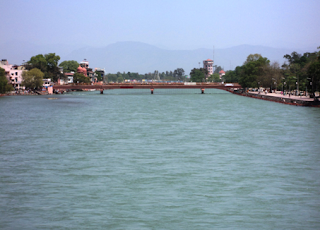Write any two pillars of the 'Mamami Gange programe'?
here are two pillars of the Namami Gange program:
- Sewerage Treatment Infrastructure: The program focuses on reducing pollution from industries, sewage treatment plants, and other sources. This will improve the water quality of the Ganges and make it safe for drinking, bathing, and other uses.
- River-Front Development: The program focuses on restoring the natural flow of the Ganges, improving the river's ecosystem, and increasing biodiversity. This will help to make the Ganges a healthier and more sustainable river.
Here are some other pillars of the Namami Gange program:
- River-Surface Cleaning: This involves cleaning up garbage and other pollutants from the river surface.
- Biodiversity: This involves planting trees and other vegetation along the riverbanks to improve the river's ecosystem.
- Afforestation: This involves planting trees along the riverbanks to improve the river's ecosystem.
- Public Awareness: This involves educating the public about the importance of protecting the Ganges River.
- Industrial Effluent Monitoring: This involves monitoring industrial effluents to ensure that they meet the required standards before being discharged into the river.
- Ganga Gram: This involves developing villages along the riverbanks into model villages that are clean, green, and sustainable.
The Namami Gange program is a comprehensive effort to protect and conserve the Ganges River. The program is expected to have a positive impact on the environment, the economy, and the lives of millions of people who depend on the river.
The "Namami Gange" program, aimed at cleaning and rejuvenating the Ganga River in India, is built upon several pillars to address the multifaceted challenges related to the river's pollution and degradation. Two key pillars of the program are:
Sewerage Infrastructure Development: One important pillar of the "Namami Gange" program is the development of sewerage infrastructure in order to reduce the discharge of untreated sewage into the Ganga and its tributaries. This involves the construction and upgrading of sewage treatment plants (STPs), sewage collection networks, and sewage pumping stations in urban and rural areas along the river. Proper treatment of sewage before its release into water bodies helps prevent contamination and improves water quality.
Industrial Pollution Control: Another crucial pillar focuses on controlling industrial pollution and regulating the discharge of industrial effluents into the Ganga River. This involves enforcing stringent pollution control measures on industries located along the river and its tributaries. The program encourages industries to adopt cleaner production practices, install effluent treatment facilities, and adhere to environmental regulations to minimize the negative impact of industrial discharges on the water quality of the Ganga.
These pillars, along with other components of the program, work together to address various sources of pollution and environmental degradation, aiming to restore the ecological health and cultural significance of the Ganga River.






0 Comments